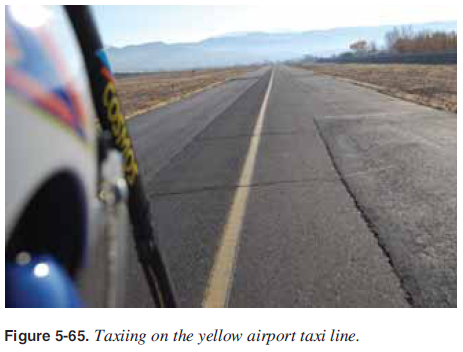
 |
|
||
| CHAPTER 5. Prefl ight and Ground Operations
Taxiing Since an aircraft is moved under its own power between the startup area and the runway, the pilot must thoroughly understand and be profi cient in taxi procedures. When the brakes are fi rst released and the aircraft starts to roll, the brakes should be tested immediately for proper operation. Applying power to start the WSC aircraft moving forward slowly, then retarding the throttle and simultaneously applying pressure smoothly on the brake may be needed to accomplish this. If braking action is unsatisfactory, the engine should be shut down immediately. When yellow taxiway centerline stripes are provided, they should be followed unless it becomes necessary to deviate to clear aircraft or obstructions. [Figure 5-65]  An awareness of other aircraft that are taking off, landing, or taxiing, and consideration for the right-of-way of others is essential to safety. When taxiing, the pilot’s eyes should be looking outside the aircraft, to the sides, as well as the front. The pilot must be aware of the entire area around the aircraft to ensure that it clears all obstructions, people, animals, and other aircraft. If at any time there is doubt about the clearance from an object, the pilot should stop the aircraft and check the clearance. The WSC aircraft does have the advantage of the wing tip capability of being raised and lowered to clear objects. It is diffi cult to set any rule for a single, safe taxiing speed. What is reasonable and prudent under some conditions may be hazardous under others. The primary requirements for safe taxiing are positive control, the ability to recognize potential hazards in time to avoid them, and the ability to stop or turn where and when desired without undue reliance on the brakes. Pilots should proceed at a cautious speed on congested or busy ramps. Normally, the speed should be at the rate at which movement of the aircraft is dependent on the throttle. That is, the speed should be low enough that when the throttle is closed, the aircraft can be stopped promptly. A GPS provides this speed since the airspeed indicator is not effective at these lower speeds. A rule of thumb is 5 mph, brisk walking speed, or 10 mph for long unobstructed areas. When taxiing, it is best to slow down before attempting a turn. WSC aircraft taxi with the wing typically held in a neutral position, but stronger winds may require positioning of the wing so it cannot be lifted. Position controls properly for wind conditions:
|
| ©AvStop Online Magazine Contact Us Return To Books |